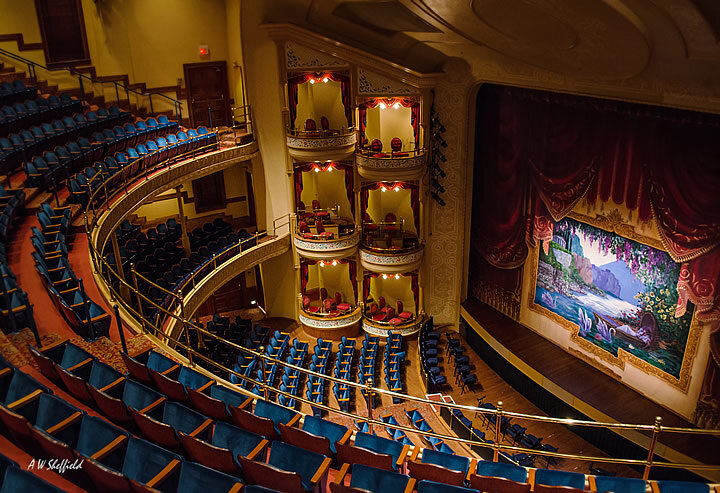Opera House
The Grand 1894 Opera House, located at 2020 Postoffice Street in Galveston’s Historic Downtown Cultural Arts District, has a very special place in the history of the island and in the hearts of its citizens.
The Grand was built in the Romanesque Revival style, with a seating capacity of 1,040. When it opened, it had the largest stage in the state of Texas (70’ x 37’ x 69’). Even today, a whisper on stage can be heard without a microphone. No seat in the audience is further than 70 feet from the stage.
The opera house survived the Great Storm of 1900 and another major storm in 1915, as well as Hurricanes Carla and Alicia and Ike. It has also survived years of neglect at various times in this illustrious history.
This year, in the middle of its 125th anniversary season, The Grand was forced to close because of the Covid-19 pandemic. But, knowing the determination of the people of Galveston, the closure is only temporary. When the time is right, the Grand 1894 Opera House will be filled to capacity once again, and all will be enjoying another great season of live performances on its stage.
In the meantime, we will remain patient and look forward to the upcoming season and another terrific lineup of shows and great experiences.
Community Commitment
In 1894, Henry Greenwall, a theater manager, raised 100,000 for the construction of the opera house, with substantial commitments made by a handful of prominent businessmen and civic-minded residents. And, when more than $8 million was raised between 1974-1990 for the Grand’s restoration, it was another remarkable community effort.
Support came from individuals, the business and corporate community, local government and, of course, included generous foundation support from around the state and nation. Chief among these were the generous leadership gifts of the Harris and Eliza Kempner Fund, The Moody Foundation, Houston Endowment and the subsequent gifts of George and Cynthia Mitchell to help complete the restoration.
The 1894 Grand Opera House is listed on the National Register of Historic Landmarks and is a Recorded Texas Historic Landmark.
-
2022
- Mar 17, 2022 Ivy Dishes
- Jan 29, 2022 Grace Episcopal Church
- Jan 1, 2022 100 Years
-
2021
- Aug 25, 2021 My Fig Tree
- Apr 28, 2021 Darlene's Shrimp
- Apr 24, 2021 Oleander Festival
- Feb 27, 2021 Great Winter Storm
- Feb 10, 2021 The Mourning Wave
-
2020
- Oct 26, 2020 Crepe Myrtles
- Sep 18, 2020 Trimming the Palms
- Jul 19, 2020 The Dancers
- Jul 11, 2020 Postcards
- Jun 20, 2020 Resilience Flag
- Jun 19, 2020 Juneteenth
- Jun 10, 2020 Silk Stocking
- May 27, 2020 Tree Sculptures
- May 6, 2020 Babe's Beach
- Apr 22, 2020 Opera House
- Mar 2, 2020 Texas Heroes Monument
- Feb 15, 2020 Mardi Gras Parade
- Jan 19, 2020 St. Joseph's Church
-
2019
- Dec 15, 2019 Celebrations
- Nov 6, 2019 Fresh Paint
- Oct 21, 2019 Jazz Age Series
- Oct 20, 2019 ARToberFEST
- Oct 6, 2019 Stingeree
- Oct 5, 2019 Pumpkin Time
- Oct 2, 2019 Sea Turtles
- Sep 29, 2019 Powhatan House
- Sep 24, 2019 The Dolphins
- Sep 5, 2019 Lucas Apartments
- Aug 24, 2019 Sandcastles
- Aug 9, 2019 The Daily News
- Jul 18, 2019 Beach Walk
- Jul 10, 2019 La King's
- May 25, 2019 Pleasure Pier
- May 1, 2019 Bolivar Ferry
- Mar 15, 2019 Saengerfest Park
- Jan 19, 2019 Moody Mansion
-
2018
- Dec 18, 2018 The Vintage Suitcase
- Dec 17, 2018 Festival of Lights
- Dec 2, 2018 Sunday Brunch
- Nov 21, 2018 Hendley Row
- Oct 27, 2018 Island Oktoberfest
- Sep 20, 2018 The Strand Clock
- Sep 16, 2018 St. Mary Cathedral
- Aug 11, 2018 No More Shed
- Jun 10, 2018 Rosenberg Library
- May 7, 2018 Stepping It Up
- May 3, 2018 A Happy Hour
- May 1, 2018 Ashton Villa
- Apr 21, 2018 96th Birthday
- Apr 1, 2018 Seawolf Park
- Mar 27, 2018 Ball High School
- Mar 15, 2018 East End
- Feb 1, 2018 Tremont House
- Jan 26, 2018 Menardi Gras
- Jan 24, 2018 Mardi Gras Decor
-
2017
- Dec 1, 2017 Miss Ruby
- Oct 8, 2017 Railroad Museum
- Oct 7, 2017 Tall Ship Elissa
- Sep 9, 2017 Star Drug Store
- Sep 8, 2017 1900 Storm Statue
- Aug 6, 2017 The Turquoise Table
- Aug 1, 2017 Bishop's Palace
- Jul 23, 2017 Garten-Verein
- Jul 21, 2017 Yard Work
- Jul 16, 2017 The Strand
- Jun 17, 2017 Stewart Beach
- Jun 7, 2017 The Original
- Jun 3, 2017 Murdochs
- May 27, 2017 Bryan Museum
- May 19, 2017 Firemen on Call
- May 13, 2017 Williams-Borden Neighborhood
- May 1, 2017 Oleander City
- Apr 28, 2017 God Winks


